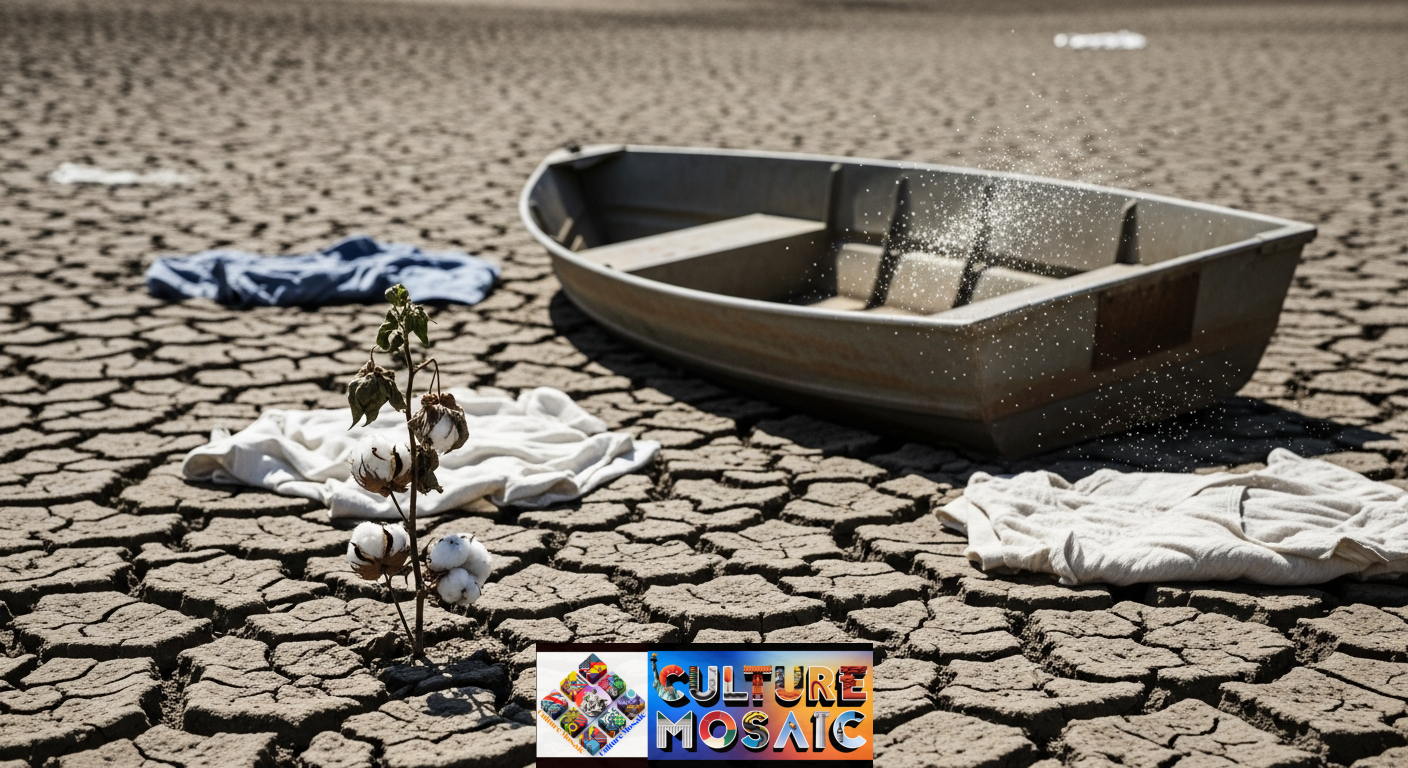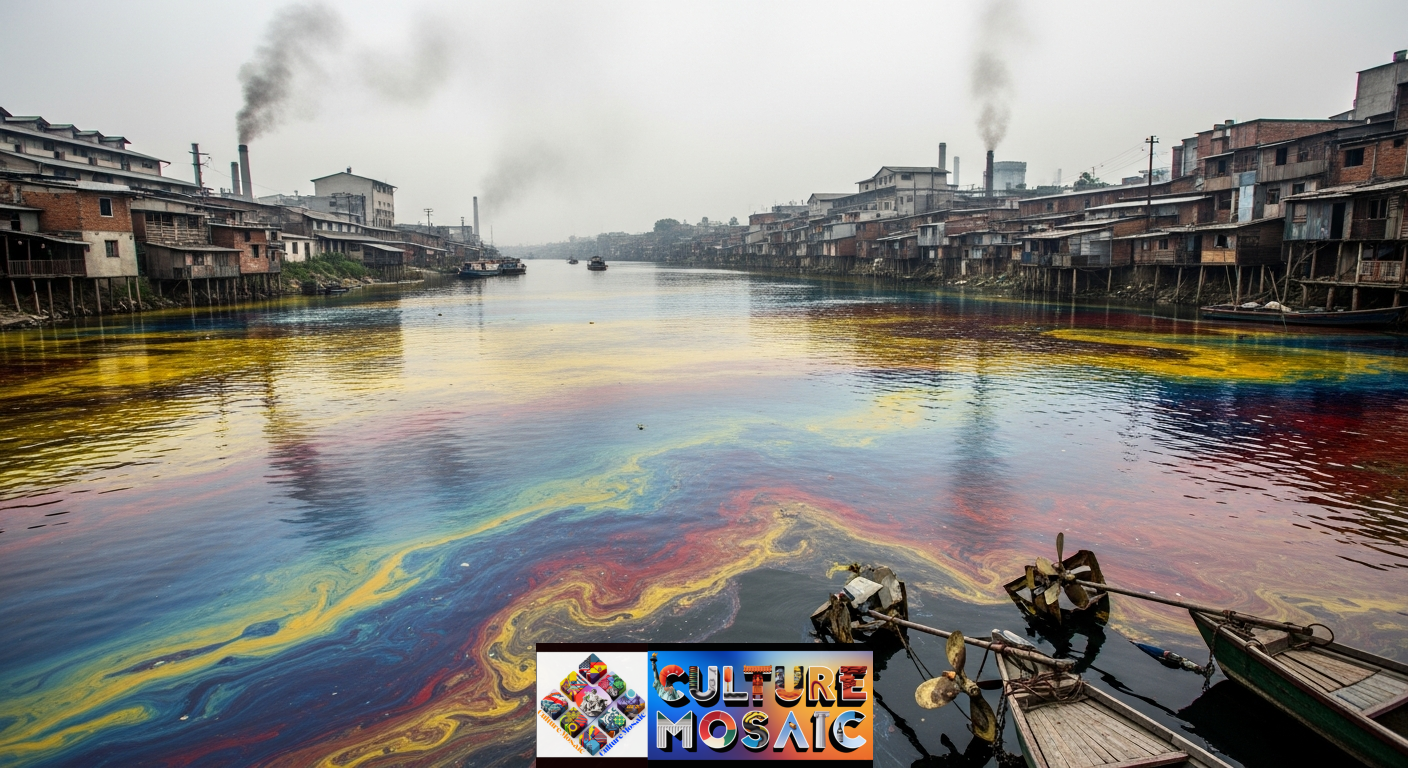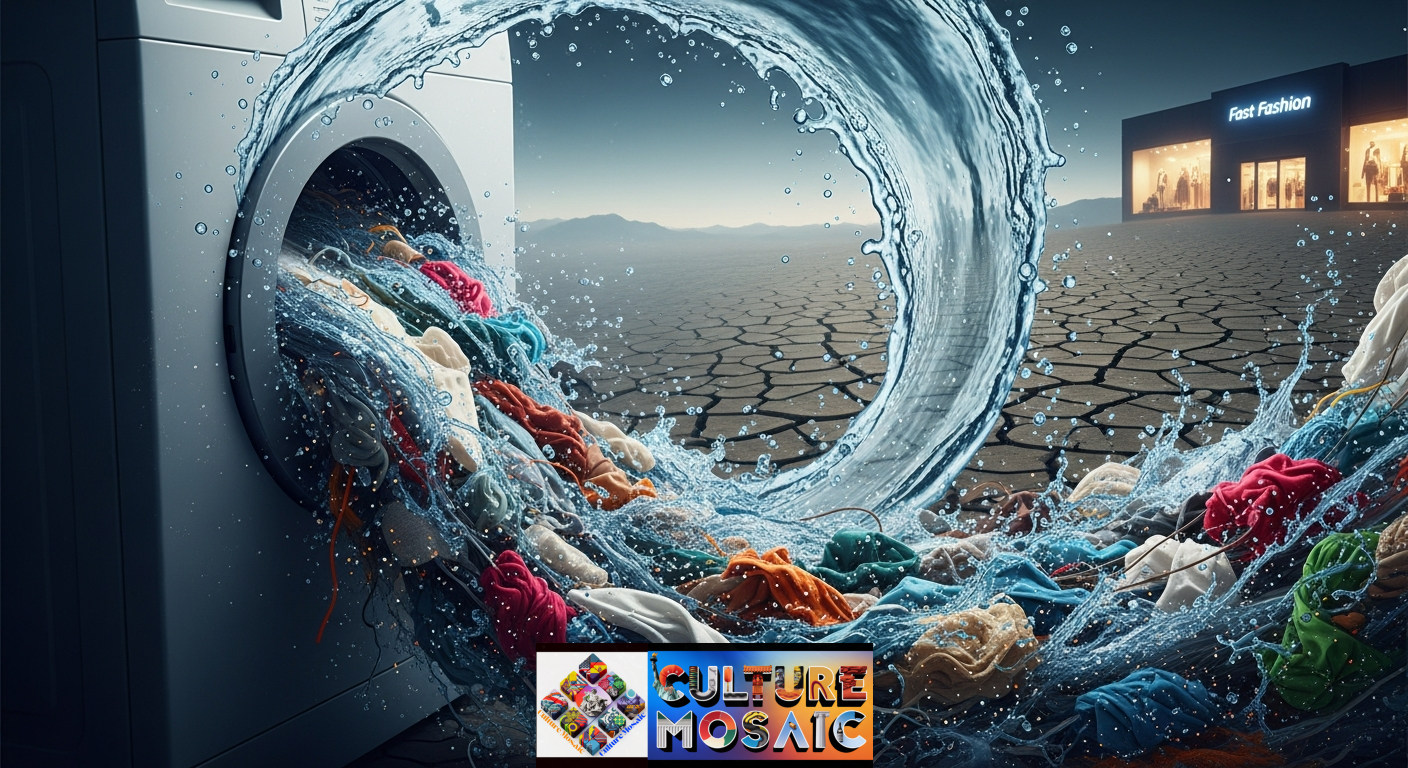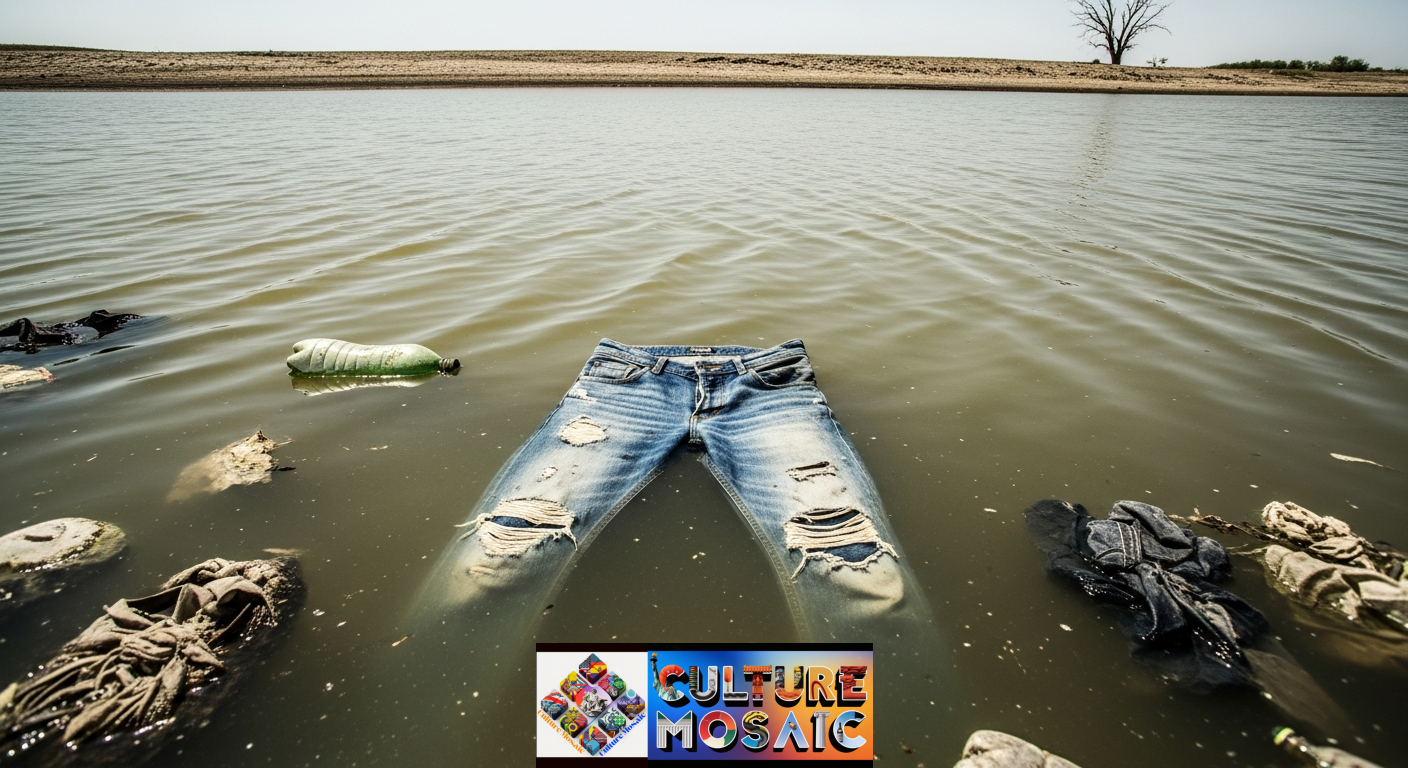Every garment you own carries an invisible burden of water consumption and pollution. The water footprint of global threads and textiles has become one of the most urgent environmental challenges facing our planet. Yet, most consumers remain completely unaware of the thousands of liters embedded in their everyday clothes.
Understanding the water footprint of global threads and textiles means looking beyond the finished product to examine every stage of textile production. From the cotton fields consuming entire rivers to the dyeing facilities poisoning waterways, the fashion industry‘s relationship with water has reached a crisis point that demands immediate attention.
What Is the Water Footprint of Global Threads and Textiles?
The water footprint of global threads and textiles encompasses the total volume of freshwater used to produce clothing from start to finish. This includes water consumed during fiber cultivation, water used in manufacturing processes, water polluted through chemical treatments, and even the water used when consumers wash their garments at home.
When researchers calculate the water footprint of global threads and textiles, they’re measuring three distinct categories. Blue water refers to surface and groundwater used for irrigation and processing. Green water means rainwater stored in soil that plants use. Grey water represents the freshwater needed to dilute pollutants to acceptable levels. Together, these components reveal the true environmental cost of textile production.
A single cotton t-shirt carries a water footprint of approximately 2,700 liters. That amount of water would last one person almost three years. A pair of denim jeans demands 7,500 liters or more. When you consider that Americans purchase around 60 new clothing items annually, the cumulative water footprint of global threads and textiles becomes staggering.
The Water Footprint of Global Threads and Textiles: Fiber by Fiber Breakdown

Understanding the water footprint of global threads and textiles requires examining which materials demand the most water and why certain fibers create disproportionate environmental impact.
Conventional Cotton and the Water Footprint of Global Threads and Textiles
Cotton dominates discussions about the water footprint of global threads and textiles because it represents both massive consumption and devastating environmental consequences. Conventional cotton requires between 10,000 to 20,000 liters of water to produce just one kilogram of fiber, making it one of the thirstiest crops on earth.
The water footprint of global threads & textiles reaches crisis levels in regions where cotton cultivation has depleted entire ecosystems. The Aral Sea in Central Asia once ranked as the world’s fourth-largest lake. Cotton irrigation for textile production diverted its water sources, shrinking the sea to less than 10% of its original size. Former fishing villages now sit surrounded by toxic salt flats where boats rust in what used to be the lake bed.
In India, cotton cultivation accounts for roughly 6% of total water usage despite occupying only 5% of cultivated land. The water footprint of global threads and textiles in India has created severe conflicts between agricultural needs and community water access. Farmers in Maharashtra and Gujarat face devastating water shortages while continuing to grow cotton for the global market.
Organic Cotton’s Impact on the Water Footprint of Global Threads and Textiles
Organic cotton dramatically reduces the water footprint of global threads and textiles compared to conventional methods. Organic farming relies primarily on rain-fed irrigation rather than artificial water systems, cutting water consumption by approximately 91%. This distinction matters enormously when calculating the true water footprint of global threads & textiles.
The water used for organic cotton is mainly green water from rainfall, whereas conventional cotton depletes blue water from rivers and aquifers. This shift significantly improves the overall water footprint of global threads and textiles while protecting vulnerable water systems in manufacturing regions.
Synthetic Fibers and the Water Footprint of Global Threads & Textiles
Polyester and other synthetics appear to reduce the water footprint of global threads and textiles during production, using only about 10 liters per kilogram compared to thousands for cotton. However, synthetic materials create a hidden dimension of the water footprint of global threads & textiles through microplastic pollution.
Every wash cycle releases hundreds of thousands of microplastic fibers from synthetic garments. These microscopic threads flow through wastewater treatment plants and enter rivers and oceans. When calculating the complete water footprint of global threads and textiles, this ongoing pollution must be factored into synthetic fiber totals. The microplastics from textiles have been found in Arctic ice, deep ocean trenches, rainfall, and even human blood.
Alternative Fibers and the Water Footprint of Global Threads and Textiles
Hemp, linen, and other alternative materials offer paths toward reducing the water footprint of global threads and textiles. Hemp uses approximately 2,400 liters per kilogram and grows without heavy pesticides or irrigation. Linen requires about 6,500 liters per kilogram, less than cotton but still substantial. Recycled fibers avoid the water costs of virgin production entirely, significantly lowering the water footprint of global threads & textiles.
Dyeing and Finishing: The Hidden Dimension of the Water Footprint of Global Threads and Textiles

While fiber production dominates discussions about the water footprint of global threads and textiles, the dyeing and finishing stages create equally devastating water pollution. Textile dyeing accounts for up to 20% of global industrial water pollution, making it one of the most environmentally destructive aspects of the water footprint of global threads & textiles.
Water Consumption in Textile Processing
A single textile mill processing the water footprint of global threads and textiles can use 200 tons of water for every ton of fabric produced. This water becomes contaminated with thousands of chemicals, including dyes, heavy metals like lead and chromium, formaldehyde, and chlorine compounds. The water footprint of global threads & textiles extends beyond volume to include severe quality degradation.
Azo dyes, representing 60-70% of all textile dyes, can break down into carcinogenic compounds. When examining the water footprint of global threads and textiles, these chemical contaminants represent ongoing environmental damage that persists long after production ends.
Geographic Impact of the Water Footprint of Global Threads and Textiles
The water footprint of global threads and textiles hits hardest in manufacturing hubs across Asia. Bangladesh produces more garments than almost any country except China, and its waterways bear the burden. The Buriganga River, flowing through Dhaka, has been declared biologically dead due to textile effluent. The water footprint of global threads & textiles has rendered the river so toxic that it corrodes boat propellers.
In Tirupur, India’s knitwear capital, the water footprint of global threads and textiles turned the Noyyal River into a toxic channel. Decades of untreated dyeing effluent meant farmers downstream could no longer irrigate crops. The Supreme Court eventually ordered the closure of hundreds of dyeing units, but the damage from the water footprint of global threads & textiles continues to affect the water table.
China faces similar devastation from the water footprint of global trends and textiles. Research indicates 70% of China’s lakes and rivers are polluted, with textile dyeing identified as a major contributor. Villages near dyeing facilities report abnormally high cancer rates, directly linked to the water footprint of global threads and textiles.
The Consumer Phase of the Water Footprint of Global Threads & Textiles

The water footprint of global threads and textiles doesn’t end when garments leave the factory. Consumer behavior, particularly washing frequency and methods, significantly contributes to the total water footprint of global threads & textiles.
Washing and the Water Footprint of Global Threads and Textiles
Americans wash clothes frequently, often after a single wear. Each laundry load uses 40-60 liters of water. Over a garment’s lifetime, washing can account for a substantial portion of the total water footprint of global threads and textiles, sometimes exceeding production water usage.
The water footprint of global threads & textiles during consumer use also includes microplastic release. A single load of synthetic laundry releases up to 700,000 microplastic fibers. These fibers represent an ongoing pollution dimension of the water footprint of global threads & textiles that continues throughout a garment’s life.
Fast Fashion Acceleration of the Water Footprint of Global Threads & Textiles
Fast fashion has dramatically increased the water footprint of global threads and textiles by encouraging overconsumption. When clothes are designed as disposable and trends change weekly, the cumulative water footprint of global threads and textiles multiplies exponentially.
Americans now purchase five times more clothing than in 1980, while wearing items half as long. This acceleration means the textile industry must constantly increase production, raising the overall water footprint of global threads & textiles to meet manufactured demand.
Regional Water Stress and the Water Footprint of Global Threads and Textiles
The water footprint of global threads and textiles creates the most severe problems in regions already facing water scarcity. Many major textile manufacturing centers are located in water-stressed areas, intensifying the crisis created by the water footprint of global threads & textiles.
The Aral Sea Disaster and the Water Footprint of Global Threads and Textiles
The Aral Sea catastrophe illustrates what happens when the water footprint of global trades and textiles continues unchecked. Soviet planners diverted rivers feeding the sea to irrigate cotton fields, directly contributing to the water footprint of global threads & textiles entering global ethical fashion supply chains.
The sea lost 90% of its volume. Ships now rust in the former seabed. Fishing villages sit 100 kilometers from the nearest water. The cotton grown with this diverted water became part of the international water footprint of global threads & textiles, ending up in clothing sold worldwide, including in the United States.
India’s Water Crisis and the Water Footprint of Global Threads and Textiles
India produces about 26% of global cotton, making it central to the water footprint of global threads and textiles. Cotton farming has been linked to severe farmer distress and high suicide rates as the water footprint of global threads & textiles depletes local resources while farmers take on debt they cannot repay.
Textile processing facilities continue to deplete and pollute water resources. The conflict between the water footprint of global threads and textiles and community water access has triggered protests, legal battles, and forced relocations across manufacturing regions.
China’s Manufacturing and the Water Footprint of Global Threads and Textiles
China produces more textiles than any other country, making its water quality crisis inseparable from the water footprint of global threads and textiles. Nearly 60% of China’s groundwater is polluted, with textile industrial discharge being a primary cause directly connected to the water footprint of global threads & textiles.
The textile industry concentrates in already water-stressed regions like the Yangtze and Yellow River basins. Competition for clean water between the water footprint of global threats and textiles, agriculture, and residential needs has intensified dramatically.
Solutions for Reducing the Water Footprint of Global Threads & Textiles
Addressing the water footprint of global threads and textiles requires action at every level, from individual consumer choices to comprehensive industry transformation.
Consumer Actions to Lower the Water Footprint of Global Threads and Textiles
Individual choices directly impact the water footprint of global threads and textiles. Buying less and choosing quality over quantity reduces your contribution to the water footprint of global threads & textiles. Before purchasing, ask whether you’ll wear an item at least 30 times. This simple calculation dramatically reduces personal impact on the water footprint of global threads & textiles.
Choose organic cotton, hemp, and recycled fibers when possible to minimize the water footprint of global threads & textiles. Washing clothes less frequently and using cold water reduces both the water consumption and pollution dimensions of the water footprint of global threads and textiles.
Installing microfiber filters on washing machines captures up to 90% of plastic fibers, addressing the pollution component of the water footprint of global threads and textiles from synthetic garments.
Industry Innovation and the Water Footprint of Global Threads and Textiles
Technology offers promising solutions for reducing the water footprint of global threads & textiles. Waterless dyeing technologies using CO2 or air pressure can eliminate up to 60 million liters annually in a single facility, substantially lowering the water footprint of global threads and textiles.
Digital printing reduces the water footprint of global threads & textiles by 95% compared to traditional screen printing. Closed-loop systems that recycle and treat water within facilities have achieved 90% reductions in the water footprint of global threads and textiles.
Fiber innovations also address the water footprint of global threads & textiles. Alternative materials like fibers from agricultural waste require significantly less water than conventional options, directly reducing the water footprint of global threads and textiles.
Certification and Transparency in the Water Footprint of Global Threads and Textiles
Several certification systems help identify textiles with lower water footprints. The Global Organic Textile Standard (GOTS) requires water treatment and monitoring throughout processing, ensuring better management of the water footprint of global threads and textiles.
Bluesign certification minimizes water pollution in the water footprint of global threads and textiles. The Higg Index attempts to standardize measurement of the water footprint of global threads & textiles across the industry, though critics note voluntary self-reporting limits effectiveness.
True transparency requires brands to disclose the complete supply chain, including water consumption at each stage. Very few companies currently provide this level of detail about the water footprint of global threads & textiles.
Policy Solutions for the Water Footprint of Global Threads and Textiles
Government regulation remains essential for addressing the water footprint of global threads and textiles at scale. Stricter wastewater discharge standards force textile manufacturers to invest in treatment infrastructure, reducing the pollution component of the water footprint of global threads & textiles.
The European Union’s proposed Ecodesign for Sustainable Products Regulation would establish disclosure requirements for the water footprint of global threads and textiles. Similar policies in the United States could drive industry-wide improvements in the water footprint of global threads & textiles.
Extended producer responsibility laws make brands financially responsible for end-of-life management, incentivizing lower-impact design that reduces the water footprint of global threads and textiles from the outset.
The Future of the Water Footprint of Global Threads and Textiles
The water footprint of global threads and textiles represents a complex crisis requiring multifaceted solutions. Cotton depletes aquifers. Dyeing poisons rivers. Microplastics accumulate in oceans. Each dimension of the water footprint of global threads and textiles demands targeted approaches.
Some brands demonstrate what’s possible in reducing the water footprint of global threads and textiles. Patagonia publishes detailed water footprint data and has invested in organic cotton since 1996. These examples prove that dramatically lowering the water footprint of global threads & textiles is feasible.
The water footprint of global threads and textiles will only shrink when consumers demand change, investors prioritize sustainability, and policymakers implement effective regulations. The textile industry will always require water, but current consumption and pollution levels aren’t inevitable.
Understanding the water footprint of global threads & textiles empowers different choices. When you know the jeans require 7,500 liters, that shirt dye poisons a river, that washing synthetics releases plastic fibers, you can make informed decisions that collectively transform the water footprint of global threads and textiles.
Your clothes carry the water footprint of global threads & textiles. Understanding this burden helps you write a different story—one where fashion and water security coexist.
Frequently Asked Questions
What exactly is the water footprint of global threads and textiles?
The water footprint of global threads and textiles measures the total freshwater used and polluted throughout clothing production, from growing fibers to dyeing fabrics to consumer care. This includes irrigation water for crops, processing water in manufacturing, polluted water from chemical discharge, and water used during washing. A cotton t-shirt carries a water footprint of about 2,700 liters, while jeans require 7,500 liters or more. The water footprint of global threads & textiles represents one of the fashion industry’s most significant environmental impacts.
Which fabrics contribute most to the water footprint of global threads and textiles?
Conventional cotton dominates the water footprint of global threads and textiles, requiring 10,000 to 20,000 liters per kilogram of fiber. This makes cotton the thirstiest component of the water footprint of global threads & textiles. Cotton cultivation in water-stressed regions like Central Asia and India has depleted rivers and groundwater. Organic cotton reduces the water footprint of global threads & textiles by about 91%, while recycled fibers avoid virgin production water costs entirely, offering better alternatives for reducing the water footprint of global threads & textiles.
How does textile dyeing affect the water footprint of global threads and textiles?
Textile dyeing creates up to 20% of global industrial water pollution, making it critical to the water footprint of global threads and textiles. Facilities can use 200 tons of water per ton of fabric processed, with this water becoming contaminated with toxic chemicals, heavy metals, and dyes. The water footprint of global threads & textiles includes both consumption and pollution dimensions. In Bangladesh, India, and China, untreated wastewater from dyeing facilities has killed rivers and contaminated drinking water, demonstrating the devastating local impact of the water footprint of global threads and textiles.
Do synthetic fabrics reduce the water footprint of global threads and textiles?
Synthetic production uses significantly less water initially, seemingly reducing the water footprint of global threads and textiles. Polyester requires only about 10 liters per kilogram versus thousands for cotton. However, synthetics create a hidden dimension of the water footprint of global threads & textiles through microplastic pollution. Each wash releases hundreds of thousands of plastic fibers into waterways. When calculating the complete water footprint of global threads & textiles, this ongoing pollution must be included. Microplastics from the water footprint of global threads & textiles have been found in Arctic ice, oceans, and human blood.
How can I reduce my contribution to the water footprint of global threads and textiles?
You can significantly lower your impact on the water footprint of global threads textiles by buying fewer clothes and wearing them at least 30 times each. Choose organic cotton, hemp, or recycled fibers to minimize the water footprint of global threads & textiles. Wash clothes less frequently using cold water and full loads to reduce both consumption and pollution aspects of the water footprint of global threads & textiles. Install microfiber filters to capture plastic fibers from synthetic garments. Support transparent brands that disclose their water usage. Most importantly, resist fast fashion to avoid accelerating the water footprint of global threads and textiles.

